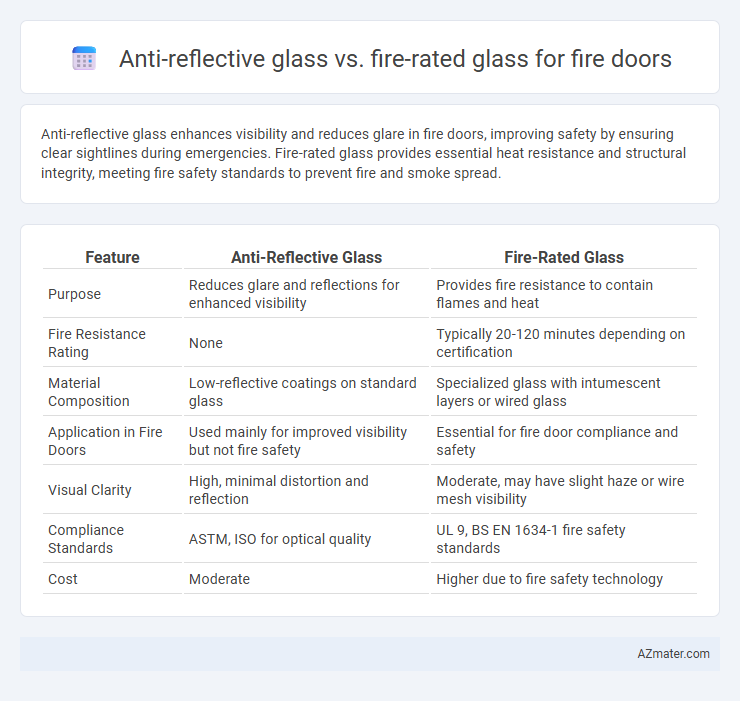Anti-reflective glass enhances visibility and reduces glare in fire doors, improving safety by ensuring clear sightlines during emergencies. Fire-rated glass provides essential heat resistance and structural integrity, meeting fire safety standards to prevent fire and smoke spread.
Table of Comparison
| Feature | Anti-Reflective Glass | Fire-Rated Glass |
|---|---|---|
| Purpose | Reduces glare and reflections for enhanced visibility | Provides fire resistance to contain flames and heat |
| Fire Resistance Rating | None | Typically 20-120 minutes depending on certification |
| Material Composition | Low-reflective coatings on standard glass | Specialized glass with intumescent layers or wired glass |
| Application in Fire Doors | Used mainly for improved visibility but not fire safety | Essential for fire door compliance and safety |
| Visual Clarity | High, minimal distortion and reflection | Moderate, may have slight haze or wire mesh visibility |
| Compliance Standards | ASTM, ISO for optical quality | UL 9, BS EN 1634-1 fire safety standards |
| Cost | Moderate | Higher due to fire safety technology |
Understanding Anti-reflective Glass: Key Features
Anti-reflective glass for fire doors reduces glare and enhances visibility by minimizing surface reflections, improving safety and aesthetics in emergency situations. Its key features include a specialized coating that maintains clarity while allowing light transmission, without compromising the fire-resistance rating of the door assembly. Unlike fire-rated glass, which primarily provides heat and flame protection, anti-reflective glass focuses on optical performance, making it ideal for environments requiring clear sightlines and compliance with fire safety standards.
Fire-rated Glass Explained: Properties and Benefits
Fire-rated glass for fire doors is designed to withstand high temperatures and prevent the spread of flames and smoke, ensuring enhanced safety during fire emergencies. It typically features multiple layers of heat-resistant materials that maintain integrity under intense heat, offering fire resistance ratings ranging from 20 minutes to over an hour. Unlike anti-reflective glass, which prioritizes visibility and clarity by reducing glare, fire-rated glass focuses on robustness, thermal insulation, and compliance with strict fire safety standards.
Importance of Glass Selection for Fire Doors
Choosing the right glass for fire doors is crucial to ensuring both safety and visibility, with fire-rated glass providing essential protection by withstanding extreme heat and preventing fire spread. Anti-reflective glass enhances visibility and reduces glare, improving user safety in areas requiring clear sightlines, but it lacks the heat resistance necessary for fire containment. Selecting glass that meets stringent fire rating standards guarantees compliance with building codes while maintaining transparency and durability in fire door applications.
Optical Performance: Anti-reflective vs Fire-rated Glass
Anti-reflective glass enhances optical clarity by reducing glare and reflections, providing near-perfect transparency ideal for fire doors requiring clear visibility. Fire-rated glass, designed to withstand high temperatures and prevent fire spread, often sacrifices some optical performance due to its multi-layered or intumescent materials. Consequently, anti-reflective glass excels in visual performance, while fire-rated glass prioritizes safety with moderate clarity.
Fire Resistance Capabilities: A Comparative Analysis
Fire-rated glass for fire doors provides superior fire resistance capabilities, meeting stringent fire safety standards by withstanding extreme heat and preventing the spread of flames and smoke for specified durations, typically ranging from 20 to 120 minutes. Anti-reflective glass, while enhancing visibility and reducing glare, lacks the specialized fire-resistant properties necessary for effective fire containment and is generally not rated for fire resistance. Selecting fire-rated glass ensures compliance with building codes and maximizes occupant safety during fire emergencies, whereas anti-reflective glass prioritizes optical clarity over fire protection.
Safety and Building Code Compliance
Fire-rated glass for fire doors ensures safety by providing critical resistance to heat and flames, meeting stringent building code requirements such as NFPA 80 and UL 10C. Anti-reflective glass enhances visibility and aesthetics but lacks the necessary fire resistance to comply with fire safety standards mandated in fire door assemblies. Selecting fire-rated glass is essential for maintaining building code compliance and ensuring optimal occupant protection during a fire event.
Aesthetic Considerations for Modern Architecture
Anti-reflective glass enhances fire doors in modern architecture by minimizing glare and maximizing transparency, creating sleek, unobstructed visuals that complement minimalist design. Fire-rated glass prioritizes safety through its robust thermal resistance and smoke seal properties, but often features a thicker, more textured appearance that can slightly reduce visual clarity. Balancing both aesthetics and safety, architects frequently choose laminated fire-rated glass with anti-reflective coatings to maintain clean lines while meeting building codes.
Cost Implications: Installation and Maintenance
Anti-reflective glass generally incurs lower upfront installation costs compared to fire-rated glass, which requires specialized materials and certified labor to meet stringent safety standards. Maintenance expenses for fire-rated glass can be higher due to the need for periodic inspections and potential replacements to ensure compliance with fire safety regulations. Choosing between the two glass types involves weighing initial cost savings against long-term compliance and maintenance obligations.
Typical Applications in Commercial and Residential Settings
Anti-reflective glass in fire doors is typically used in commercial settings such as office buildings, retail stores, and hospitals, enhancing visibility and safety without glare interference. Fire-rated glass is essential in both commercial and residential buildings, including schools, hotels, and apartment complexes, where it provides fire containment and smoke barrier properties. Combining these glasses in fire doors supports regulatory compliance and maintains clear sightlines for emergency egress while ensuring fire resistance.
Choosing the Right Glass for Fire Door Solutions
Choosing the right glass for fire door solutions involves comparing anti-reflective glass and fire-rated glass based on safety and functionality. Fire-rated glass is specially designed to withstand high temperatures and prevent fire and smoke spread, meeting stringent safety standards such as UL 9 and EN 13501-2. Anti-reflective glass enhances visibility and reduces glare but lacks fire resistance, making fire-rated glass the essential choice for code-compliant and reliable fire door applications.

Infographic: Anti-reflective glass vs Fire-rated glass for Fire door
 azmater.com
azmater.com